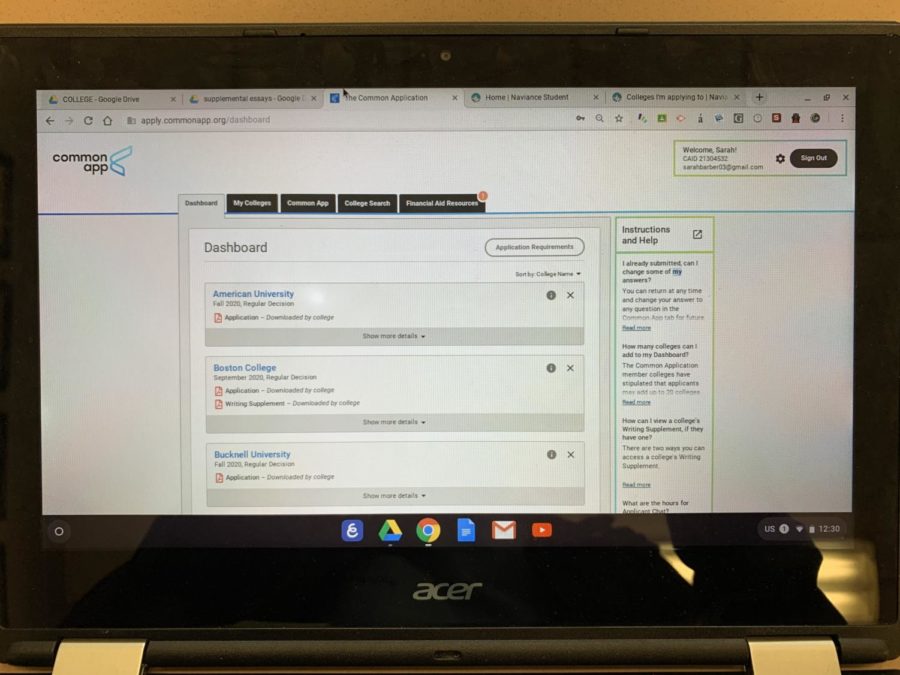Applying to college: What you might not know and where to start
I’ve had these tabs open for so long, I’m genuinely surprised they haven’t permanently frozen into my Chromebook screen.
Last week, I submitted the last five of my 13 college applications, and I thought I would be able to let out the breath I’ve been holding since halfway through junior year — I was wrong.
Now that I’m done, I’m finding myself fielding countless questions about the application process, requesting documents and essay writing. I genuinely love helping my friends, and I’m glad they trust me enough to ask me these kinds of questions, but it’s making me feel like I’m stuck in an endless loop in which all I see is the Common Application webpage.
I submitted all 13 of my college applications on my own, which was a bold task, but I ultimately came out successful on the other end of it.
The amount of people with questions got me thinking: what if I wrote an article that contained links and all of the information seniors need to successfully submit their applications? So I did.
The biggest thing
During your entire application process, the most important thing you can do is be aware of your deadlines for each school. For this I used the iPhone app, ‘Common App On Track,’ which provided an easily accessible visual layout of all of my impending applications.
A lot of DGS-specific important information can be found in College Bulletin #1.
Choosing schools
The first thing you should do is decide what you’re interested in, and if you don’t know, that’s totally OK. We’re always told to use the Naviance surveys, but, personally, those were some of the most inaccurate surveys I’ve ever taken. I narrowed down my areas of interest by researching jobs I found interesting, taking a variety of courses in high school and watching political crime dramas in my free time, this ultimately lead me to consider a career in investigative work.
Once you have a clear idea of what you want to do, it’s time to figure out where you want to be. If you don’t know your areas of interest, try searching for colleges by where you want to be geographically first.
My personal favorite way to look at colleges is the College Board’s ‘College Search’ feature. It allows you to plug in any criteria you want, and it will match you with schools based on your wants. I’ve likely spent the equivalent of three days of my life obsessing over this search program, so try not to get too sucked in.
Once you find a few schools you might like, try to research those schools and visit them if possible, while narrowing down your search to three safety schools, three schools you think you’ll get in to (on-target schools) and three reach schools, which are your shoot for the stars schools. Try your best to solidify this list as soon as you can, that way you have more time to complete all of the requirements.
Early decision, early action and regular decision: What’s the difference?
Early decision applications are typically due by Nov. 1, and they are the applications that are legally binding. This means that if you apply early decision and are accepted, you are required to attend due to previously signed documentation. Applying early decision increases your chances of acceptance, and also allows you to receive your decision earlier, around mid-December.
Early action applications are typically due by Nov. 1 or Nov. 15, however they are not legally binding. Early action allows students to receive admissions decisions early, but students are not required to attend the institution.
Regular decision applications are typically due by Jan. 1 or Jan. 15, and students receive decisions around March or April. This type of application is the most common application submitted.
Regardless of whether you apply early decision, early action, or regular decision, the contents of your applications will be the same. The only real differences are in the due dates, response dates and early decision’s binding clause.
Naviance process and transcripts
List of schools in hand, add them all into Naviance by going to the ‘colleges I’m applying to’ tab. Next, you need to request transcripts, and do it as soon as possible in order to ensure they’re sent out on time. When requesting transcripts, first go to ‘colleges I’m applying to,’ then look at the top of the page on the right side and click ‘request transcripts,’ select initial and then select all of your schools, and you’ve checked that off your to-do list.
Once you put in your transcript requests, figure out which applications they accept — most schools operate under the Common Application, but some have unique applications to their school, or operate under the Coalition For College Access application. All of my schools worked with the Common App, but it’s relatively the same process for all applications.
The rest of the steps can be completed at your pace and in your preferential order, but make sure you’re keeping up with the deadlines, which are emailed to you by Ann Lichaj.
Letters of recommendation
For counselor letters of recommendation, you need to fill out the survey in Naviance, which you’ll find under ‘about me’, ‘surveys’. For teacher letters of recommendation, you need to request them via the Google Form in Naviance, which you find at the bottom left of the screen under ‘from my school’. I would also recommend talking to the teachers you’re requesting letters from in person, just to show respect and that you’re taking the process seriously.
Filling out applications and writing essays
I personally found it easiest to fill out the Common App itself first, because it’s the majority of your application for each school. The majority of questions are generic and to gather background information, however, the most important section is the writing. Thankfully, there are multiple different prompts to choose from, plus a blanket prompt to cover any other ideas students may have.
Avoid cliches — the admissions office doesn’t want to read about your sports injury or your service trip, it’s overdone. Dig deep and set your application apart from others’. Start writing, then choose your prompt, chances are, your essay will fit one provided.
Make sure you edit and revise. Have some smart friends that you trust edit your essay, and if you think you’re good enough, offer to edit theirs. The more polished and genuine your writing is, the better.
Many schools also have supplemental essay or short-answer questions. I recommend tackling those once you’ve finished your Common App, in case your college list changes for any reason.
Finally, try not to stress
Make an effort to keep yourself as organized as possible. Keep a folder in your Google Drive containing all of your deadlines, supplemental essays and any other important information.
Being a senior is terrifying. Even though I’ve already submitted my applications, I’m oddly more stressed and anxious now as I wait for schools to announce decisions. Try to remember that you’re not the only one freaking out, and if you need help, don’t be afraid to ask for it.
If you have any other questions, or need to access specific dates, click here.


